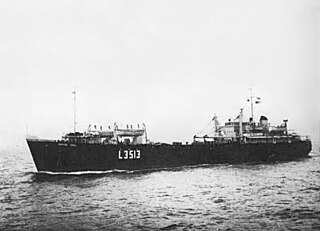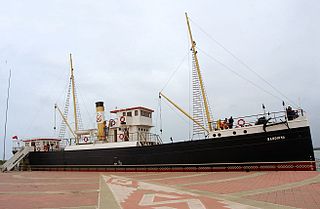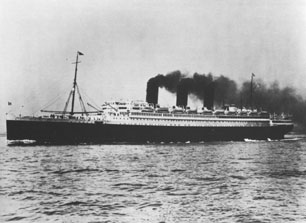
Gulls or seagulls are seabirds of the family Laridae in the suborder Lari. They are most closely related to the terns and only distantly related to auks, skimmers, and more distantly to the waders. Until the 21st century, most gulls were placed in the genus Larus, but this arrangement is now considered polyphyletic, leading to the resurrection of several genera. An older name for gulls is mews, cognate with German Möwe, Danish måge, Dutch meeuw, and French mouette; this term can still be found in certain regional dialects.

RFA Empire Gull (L3513) was a landing ship, tank of the Royal Fleet Auxiliary. She was familiarly known as the "Black Pig" and was one of the last serving British LSTs. She was built as LST 3523, one of the Empire Ships, and later commissioned as HMS Trouncer. During the Suez Crisis she was pressed into Government service as SS Empire Gull. In 1970 she was transferred to the Royal Fleet Auxiliary as RFA Empire Gull, serving for ten years before being scrapped.

A Landing ship, infantry (LSI) or infantry landing ship was one of a number of types of British Commonwealth vessels used to transport landing craft and troops engaged in amphibious warfare during the Second World War. LSIs were operated by the Royal Navy, British Merchant Navy, Royal Canadian Navy, Royal Indian Navy, and Royal Australian Navy. They transported British Commonwealth and other Allied troops in sea assaults and invasions throughout the war.

The following is a list of Registered Historic Places in Keweenaw County, Michigan.

From Hell is a 2001 American mystery horror film directed by the Hughes brothers and loosely based on the graphic novel From Hell by Alan Moore and Eddie Campbell about the Jack the Ripper murders.

Gull Island, located in St. James Township, Charlevoix County, Michigan, is the largest of approximately one dozen islands bearing this name in Michigan. 230 acres (0.9 km²) in size, it is managed by the U.S. Fish and Wildlife Service as part of the Michigan Islands National Wildlife Refuge. The refuge was created in 1943.

SS Bandırma was an Ottoman mixed-freight ship, which became famous for her historical role in taking Mustafa Kemal Pasha (Atatürk) from Constantinople (today-Istanbul) to Samsun in May 1919 that marked the establishment of the Turkish national movement.

The SS Paris was a French ocean liner built in Saint-Nazaire, France for the Compagnie Générale Transatlantique. The French Line's Paris was built by Chantiers de l'Atlantique of St. Nazaire. Although Paris was laid down in 1913, her launching was delayed until 1916, and she was not completed until 1921, due to World War I. When Paris was finally completed, she was the largest liner under the French flag, at 34,569 tons.

USS Mizar (AF-12) was a United Fruit Company cargo and passenger liner that served as a United States Navy Mizar-class stores ship in World War II.
SS Empire Abbey was a refrigerated cargo ship built in 1943 and in service until 1966. She was also known as SS Teviot, SS Ardilles and SS Tung An.

SS Uhenfels was a steam merchant ship operated initially by the German shipping firm Deutsche Dampfschiffahrts-Gesellschaft Hansa, and then shortly after the start of the Second World War by the British Elder Dempster Lines Ltd, as SS Empire Ability. She was sunk under this name in 1941 by a German U-boat.

Empire Amethyst was an 8,032 ton tanker which was built in 1941. She was torpedoed and sunk by German submarine U-154 on 13 April 1942.
Empire Gull was the name of several ships:
USS West Gambo (ID-3220) was a steel-hulled, single-screw cargo ship that served in the United States Navy from 1918 to 1919. She later saw commercial service as SS West Gambo and SS Empire Hartebeeste, and under the latter name was sunk during World War II.

Western Maid was a 5,760 GRT cargo ship that was built in 1918 by the Northwest Steel Company, Portland, Oregon, USA. She was built for the United States Shipping Board (USSB), but was commissioned into the United States Navy on completion as USS Western Maid, with the pennant number ID-3703. In 1919 she was decommissioned and returned to the USSB. In 1937 she was passed to the United States Maritime Commission. In 1940 she was transferred to the British Ministry of Shipping and renamed Empire Cormorant, passing to the Ministry of War Transport (MoWT) in 1941. In 1945 she was scuttled in the North Atlantic with a cargo of obsolete war matériel.
SS Robin Doncaster was a 7,101 GRT cargo liner that was built in 1940 as a Type C2-S cargo ship by Bethlehem Steel Co, Sparrows Point, Maryland, United States for the United States Maritime Commission (USMC). On completion in April 1941, she was transferred to the Ministry of War Transport (MoWT) and renamed Empire Curlew. In 1942, she was transferred to the USMC, regaining her former name Robin Doncaster. She was rebuilt as a troop transport, and entered service with the War Shipping Administration in January 1944. She was returned to the USMC in April 1946 and was sold to Seas Shipping Co Inc in 1948. In 1957, she was sold to Isbrandtsen Lines and was renamed Flying Gull. Sold to American Export Lines in 1962, she served until she was scrapped in 1968.

SS Pratt Victory was a United States Victory ship which served in the Pacific Theater of Operations during the last few months of World War II. The ship's US Maritime Commission (MARCOM) designation was VC2-S-AP3, hull number 782 (V-782). SS Pratt Victory was named after Pratt Institute in New York City. It was built in 76 days at the California Shipbuilding Yard (Calship) in Los Angeles, California and was delivered on 9 May 1945.

The Gull Terrier is a breed of dog that originates from the Punjab region of Pakistan and India; it is believed to be several hundred years old. They are often used in dog fighting, hunting, and guarding. This dog breed is related to the English Bull Terrier breed that comes from Great Britain. This English dog breed played a major role in the Gull Terrier’s breeding development and it is considered as the direct ancestor of the modern Gull Terrier.














